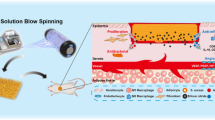Abstract
Efficient initiation and resolution of inflammation are crucial for wound repair. However, with using tissue adhesives for wound repair, patients occasionally suffered from delayed healing process because slow elimination of those exogenous adhesives generally leads to chronic inflammation. As the demand for minimal invasive therapy continues to rise, desire for adhesive materials that can effectively reconnect surgical gaps and promote wound regeneration becomes increasingly urgent. Herein, by exploiting the inherent porous structure and performance of adhesion to tissue of mesoporous silica nanoparticles (MSNs), we demonstrate a tissue adhesive that can elicit acute inflammatory response and get eliminated after tissue reformation. With formation of nanocomposites in wound gaps, the injured tissues can get reconnected conveniently. The resultant accelerated healing process verify that the strategy of exploiting unique properties of nanomaterials can effectively promote inflammation resolution and wound repair. This design strategy will inspire more innovative tissue adhesives for clinical applications.

Similar content being viewed by others
References
Gurtner, G. C.; Werner, S.; Barrandon, Y.; Longaker, M. T. Wound repair and regeneration. Nature2008, 453, 314–321.
Oberyszyn, T. M. Inflammation and wound healing. Front. Biosci.2007, 12, 2993–2999.
Eming, S. A.; Krieg, T.; Davidson, J. M. Inflammation in wound repair: Molecular and cellular mechanisms. J. Invest. Dermatol.2007, 127, 514–525.
Spotnitz, W. D.; Burks, S. Hemostats, sealants, and adhesives: Components of the surgical toolbox. Transfusion2008, 48, 1502–1516.
Annabi, N.; Tamayol, A.; Shin, S. R.; Ghaemmaghami, A. M.; Peppas, N. A.; Khademhosseini, A. Surgical materials: Current challenges and nano-enabled solutions. Nano Today2014, 9, 574–589.
Barrett, D. G.; Bushnell, G. G.; Messersmith, P. B. Mechanically robust, negative-swelling, mussel-inspired tissue adhesives. Adv. Healthc. Mater.2013, 2, 745–755.
Li, J.; Celiz A. D.; Yang J.; Yang Q.; Wamala I.; Whyte W.; Seo B. R.; Vasilyev N. V.; Vlassak J. J.; Suo Z. et al. Tough adhesives for diverse wet surfaces. Science2017, 357, 378–381.
Anderson, J. M.; Rodriguez, A.; Chang, D. T. Foreign body reaction to biomaterials. Semi. Immunol.2008, 20, 86–100.
Klopfleisch, R.; Jung, F. The pathology of the foreign body reaction against biomaterials. J. Biomed. Mater. Res. A2017, 105, 927–940.
Leggat, P. A.; Smith, D. R.; Kedjarune, U. Surgical applications of cyanoacrylate adhesives: A review of toxicity. ANZ. J. Surg.2007, 77, 209–213.
Mizrahi, B.; Stefanescu, C. F.; Yang C.; Lawlor M. W.; Ko D.; Langer R.; Kohane D. S. Elasticity and safety of alkoxyethyl cyanoacrylate tissue adhesives. Acta Biomater.2011, 7, 3150–3157.
Klimo, P. Jr.; Khalil, A.; Slotkin, J. R.; Smith, E. R.; Scott, R. M.; Goumnerova, L. C. Wound complications associated with the use of bovine serum albumin-glutaraldehyde surgical adhesive in pediatric patients. Neurosurgery2007, 60, 305–309.
LeMaire, S. A.; Schmittling, Z. C.; Coselli, J. S.; Ündar, A.; Deady, B. A.; Clubb, F. J.; Fraser, C. D. BioGlue surgical adhesive impairs aortic growth and causes anastomotic strictures. Ann. Thorac. Surg.2002, 73, 1500–1505.
Wu, H. B.; Li, F. Y.; Wang, S. F.; Lu, J. X.; Li, J. Q.; Du, Y.; Sun, X. L.; Chen, X. Y.; Gao, J. Q.; Ling, D. S. Ceria nanocrystals decorated mesoporous silica nanoparticle based ROS-scavenging tissue adhesive for highly efficient regenerative wound healing. Biomaterials, 2018, 151, 66–77.
Meddahi-Pelle, A.; Legrand, A.; Marcellan, A.; Louedec, L.; Letourneur, D.; Leibler, L. Organ repair, hemostasis, and in vivo bonding of medical devices by aqueous solutions of nanoparticles. Angew. Chem., Int. Ed.2014, 53, 6369–6373.
Stöber, W.; Fink, A.; Bohn, E. Controlled growth of monodisperse silica spheres in the micron size range. J. Colloid Interface Sci.1968, 26, 62–69.
Renwick, L. C.; Brown, D.; Clouter, A.; Donaldson, K. Increased inflammation and altered macrophage chemotactic responses caused by two ultrafine particle types. Occup. Environ. Med.2004, 61, 442–447.
Gustafson, H. H.; Holt-Casper, D.; Grainger, D. W.; Ghandehari, H. Nanoparticle uptake: The phagocyte problem. Nano Today2015, 10, 487–510.
Shen, D.; Yang, J. P.; Li, X. M.; Zhou, L.; Zhang, R. Y.; Li, W.; Chen, L.; Wang, R.; Zhang, F.; Zhao, D. Y. Biphase stratification approach to three-dimensional dendritic biodegradable mesoporous silica nanospheres. Nano Lett.2014, 14, 923–932.
Rose, S.; Prevoteau, A.; Elzière, P.; Hourdet, D.; Marcellan, A.; Leibler, L. Nanoparticle solutions as adhesives for gels and biological tissues. Nature2014, 505, 382–385.
Lundqvist, M.; Sethson, I.; Jonsson, B. H. Protein adsorption onto silica nanoparticles: Conformational changes depend on the particles’ curvature and the protein stability. Langmuir2004, 20, 10639–10647.
Hata, K.; Higashisaka, K.; Nagano, K.; Mukai, Y.; Kamada, H.; Tsunoda, S. I.; Yoshioka, Y.; Tsutsumi, Y. Evaluation of silica nanoparticle binding to major human blood proteins. Nanoscale Res. Lett.2014, 9, 668.
Yang, G. B.; Phua, S. Z. F.; Bindra, A. K.; Zhao, Y. L. Degradability and clearance of inorganic nanoparticles for biomedical applications. Adv. Mater., 2019, 31, 1805730.
Mustoe, T. A.; Pierce, G. F.; Thomason, A.; Gramates, P.; Sporn, M. B.; Deuel, T. F. Accelerated healing of incisional wounds in rats induced by transforming growth factor-beta. Science1987, 237, 1333–1337.
Acknowledgements
This work was supported by the National Natural Science Foundation of China (Nos. 51732011, 21431006, 21761132008, 51471157, 21401183, and 21771168), the Foundation for Innovative Research Groups of the National Natural Science Foundation of China (No. 21521001), Key Research Program of Frontier Sciences, CAS (No. QYZDJ-SSW-SLH036), the National Basic Research Program of China (No. 2014CB931800), the Users with Excellence and Scientific Research Grant of Hefei Science Center of CAS (No. 2015HSC-UE007), the Youth Innovation Promotion Association of CAS (No. 2014298). This work was partially carried out at the USTC Center for Micro and Nanoscale Research and Fabrication.
Author information
Authors and Affiliations
Corresponding authors
Rights and permissions
About this article
Cite this article
Pan, Z., Zhang, KR., Gao, HL. et al. Activating proper inflammation for wound-healing acceleration via mesoporous silica nanoparticle tissue adhesive. Nano Res. 13, 373–379 (2020). https://doi.org/10.1007/s12274-020-2619-x
Received:
Revised:
Accepted:
Published:
Issue Date:
DOI: https://doi.org/10.1007/s12274-020-2619-x




